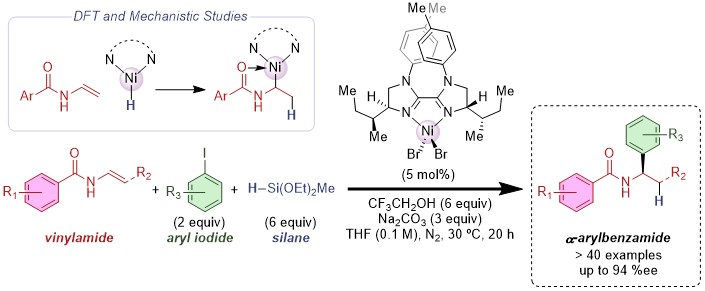Nickel-Catalyzed Asymmetric Synthesis of α-Arylbenzamides
α-Arylbenzamides are pharmacologically relevant and ubiquitous motifs, present in anti-cancer agents,[2a] SARS-CoV PLpro inhibitors[2b] and anti-depressants among many other bioactive molecules.[2c] However, despite their unquestionable importance, straightforward methods to access these enantiomerically enriched motifs are still elusive.
Currently established strategies include the direct enantioenriched arylation of the corresponding C-H bond[3a] or the hydrogenation of α-amidostyrenes[3b] among others. Our methodology relies on an elegant 3-component asymmetric hydroarylation of vinylamides, catalyzed by a chiral Ni-bisimidazoline complex. Control experiments and DFT calculations support a mechanism based on the addition of an in situ-formed Ni-hydride complex onto the olefin. The excellent enantiomeric excess (up to 94 %ee) is explained by the coordination of the carbonyl group to the Ni atom.
The broad scope (> 40 examples) demonstrates that the reaction tolerates different functional groups (nitrile, ketone, ester, boronic ester, etc.) and electronic properties in the aryl ring (EWG and EDG), both in the vinylamide as well as in the aryl iodide. Examples using ortho-substituted aryl iodides, vinyl bromides, benzyl bromide and more complex substrates bearing additional stereocenters are also included in this work.

[2] a) D. S. Palacios, E. Meredith, T. Kawanami, C. Adams, X. Chen, V. Darsigny, E. Geno, M. Palermo, D. Baird, G. Boynton, S. A. Busby, E. L. George, C. Guy, J. Hewett, L. Tierney, S. Thigale, W. Weihofen, L. Wang, N. White, M. Yin, U. A. Argikar, Bioorg. Med. Chem. Lett. 2018, 28, 365–370. b) V. Peddie, M. Pietsch, K. M. Bromfield, R. N. Pike, P. J. Duggan, A. D. Abell, Synthesis 2010, 1845–1859. c) Y. Zhao, J. Chen, Q. Liu, Q. Li, Molecules 2020, 25, 406.
[3] a) A. W. Rand, H. Yin, L. Xu, J. Giacoboni, R. Martin-Montero, C. Romano, J. Montgomery, R. Martin, ACS Catal. 2020, 10, 4671–4676. b) K. Matsumura, H. Shimizu, T. Saito, H. Kumobayashi, Adv. Synth. Catal. 2003, 345, 180–184.